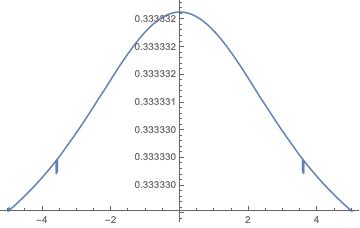I would like to ask a follow up on a question I asked some days ago.
Consider the function
$$f_{n}(x)=e^{-x^2}x^n.$$
My goal then was to analyze
$$ F(y):=\frac{(f_2*f_0)(y)}{(f_0*f_0)(y)}- \left(\frac{(f_1*f_0)(y) }{(f_0*f_0)(y)}\right)^2$$
and Iosif Pinelis showed that this expression is constant.
Now instead of convolving with $f_0(x)=e^{-x^2}$ one could convolve with a function that decays slower than $e^{-x^2}$ for example $g_0(x)=e^{-\vert x \vert}.$ That is, we then get
$$ G(y):=\frac{(f_2*g_0)(y)}{(f_0*g_0)(y)}- \left(\frac{(f_1*g_0)(y) }{(f_0*g_0)(y)}\right)^2.$$
Mathematica shows that $G$ is now not at all constant but has a unique maximum at $0$ and decreases from there.
On the other hand one can consider the faster decaying function $h_0(x)=e^{-x^4}$ and consider
$$ H(y):=\frac{(f_2*h_0)(y)}{(f_0*h_0)(y)}- \left(\frac{(f_1*h_0)(y) }{(f_0*h_0)(y)}\right)^2.$$
In this case, the function has a unique minimum at zero and increases from there.
All functions $F,G$ and $H$ are positive by the Cauchy-Schwarz inequality.
So to summarize for
- slow decay - $G$ has a unique minimum (Fig. 1)
- medium decay-$F$ is a constant function.
- fast decay - $H$ has a unique maximum (Fig. 2).
I also checked the exponent $e^{-\vert x \vert^{2+10^{-5}}}$
 $e^{-\vert x \vert^{2+10^{-5}}}$" />
$e^{-\vert x \vert^{2+10^{-5}}}$" />
and it seems the function has the expected behaviour.
I also checked for log-convexity/log-concavity. Apparently, the functions $G,H$ are neither log-convex nor log-concave.
See here a plot for $\log(G)$

 $e^{-\vert x \vert}$" />
$e^{-\vert x \vert}$" /> $e^{-\vert x \vert^4}$" />
$e^{-\vert x \vert^4}$" />